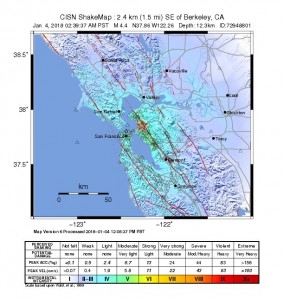Sophomore Afreen Azad had turned off the lights and was just about to go to bed around 2 a.m. when she suddenly felt like someone was shaking her bed. Azad’s first thought was that her house was being robbed.
“I heard from someone who lives near our street that there was a person knocking on their door trying to get in, and I got so scared,” Azad said. “[But then] I also have a fear of clowns and dolls, and I was like, ‘Oh my gosh, it’s probably like my nightmares coming true.’ I thought I was hallucinating because of lack of sleep.”
After the shaking had stopped, Azad immediately checked her social media and, through her friends, learned that an earthquake had taken place.
According to the U.S. Geological Survey, a 4.4 magnitude earthquake occurred on the Hayward Fault in Berkeley at 2:39 a.m. on Thursday, Jan. 4. While sophomore Patricia Saito knows that earthquakes are a common occurrence in California, she was still surprised by this earthquake.

“It was kind of unexpected because the last time I actually felt an earthquake was probably about ten years ago,” Saito said. “[That earthquake] went on for a very long time, so I was surprised that [this one] was so short.”
Library media teacher Laura Utile believes that because the more imminent threat of earthquakes in California increases people’s emphasis on earthquake preparation because of their expectations.
“[As] a native Californian, [I am] just so used to doing the earthquake preparedness [drills] that it doesn’t really bother [me] as much,” Utile said. “Whereas hurricanes and tornadoes absolutely terrify me.”
Utile, who experienced the 6.9 magnitude Loma Prieta earthquake of 1989, explains that despite preparedness, damage can still occur.
“It doesn’t sound like there was any major damage anywhere, which is pretty lucky,” Utile said. “When I was in college at Santa Clara [University,] we had the big earthquake in ’89 in October and there was a lot of superficial damage to buildings.”
Both Saito and Azad agree that the lack of noticeable effects from recent earthquakes, whether it be damage to infrastructure or violent shaking, has resulted in a sense of complacency when it comes to earthquake preparedness, in the sense of doing earthquake drills and storing food and water in case of emergency.
“People always say that [earthquakes are] a common thing in California but in reality we don’t actually personally face earthquakes that often,” Saito said. “A lot of times the earthquake stuff you learn just goes in one ear and out the other, and I think after the earthquake, its more real in people’s minds.”










